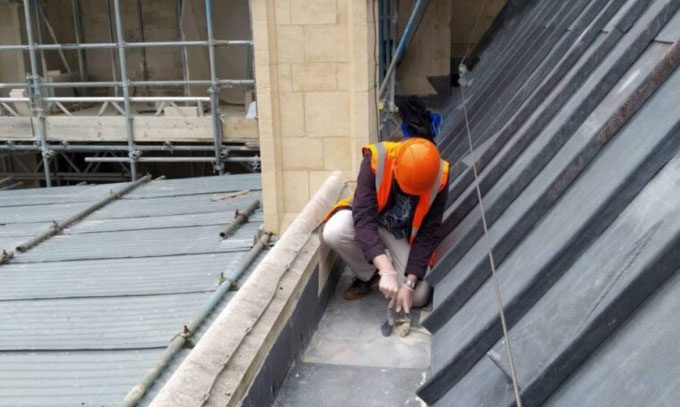With their advantageous size and remote nature, the roofs of large cathedrals serve as ideal locations to collect cosmic dust.
When donning dust-collecting backpacks and climbing the cathedral walls, the research team from the University of Kent resembles ghost hunters more than planetary scientists. However, for them, this equipment is crucial for collecting cosmic dust that has settled on the roofs of ancient buildings after falling to Earth, as reported by the Guardian on July 31.

Researcher Matthias van Ginneken collecting cosmic dust on the roof of Canterbury Cathedral. (Photo: Ross Kaniuk Media/Penny Wozniakiewicz).
Dr. Penny Wozniakiewicz and Dr. Matthias van Ginneken plan to visit cathedrals across England to search for cosmic dust, aiming to understand how much material from space falls to Earth, becoming part of the atmosphere or the blue planet.
The roofs of large cathedrals are excellent sites for hunting cosmic dust due to their size and inaccessibility. “You need a location that is as undisturbed as possible. Dust falls everywhere, but rooftops provide a good opportunity to collect dust without people trampling over it,” Wozniakiewicz stated.
Dust particles from asteroids and comets crash into Earth’s atmosphere at speeds of tens of thousands of kilometers per hour. A significant amount burns up during this process, but some melt and then solidify, turning into tiny spheres scattered across the Earth’s surface.
“We want to climb onto the roof because the particles we are looking for are very interesting. They are useful for understanding the number of particles that fall to the Earth’s surface. This figure is related to the number of particles falling into the upper atmosphere, which allows us to learn about the contribution of this material to Earth,” Wozniakiewicz explained.
The scientists are advancing the project after a study discovered cosmic particles among the dust swept from a section of the Canterbury Cathedral roof replaced two years ago. The team plans to return to Canterbury in the coming weeks to collect dust from the older and larger part of the cathedral’s roof. Afterward, they will bring their equipment to the next site, Rochester Cathedral.
While wind and rain wash away large amounts of dust from the roofs, the particles found still help scientists understand the minimum amount of cosmic dust that falls. Another advantage of cathedral roofs is that their construction is meticulously documented. Thus, the dating of different roof sections and the time they accumulate dust are fully recorded.


















































